New Strategies in the Cultivation of Olive Trees and Repercussions on the Nutritional Value of the Extra Virgin Olive Oil
Abstract
1. Introduction
2. Results
2.1. Analyses of Phenolics
2.2. Phenol Content and Antioxidant Activity
2.3. Secoiridoids and Phenolic Alcohols Correlation
2.4. Variation (%) of the Most Representative Phenolics
3. Discussion
4. Materials and Methods
4.1. Study Area
4.2. Plant Material
4.3. Fungal Material
4.4. Isolation and Characterization of Harzianic Acid
4.5. Oil Production
4.5.1. Chemicals
4.5.2. Extraction of Phenolic Compounds from Olive Oil
4.5.3. Ultra High Pressure Liquid Chromatograph
4.6. Mass Spectrometry Analysis
4.7. Validation of the Method Used to Quantify Single Phenols
4.8. Total Phenolic Compounds
4.9. Antioxidant Activity Measurements
5. Conclusions
Author Contributions
Funding
Conflicts of Interest
References
- Servili, M.; Sordini, B.; Esposto, S.; Urbani, S.; Veneziani, G.; di Maio, I.; Selvaggini, R.; Taticchi, A. Biological activities of phenolic compounds of extra virgin olive oil. Antioxidants 2014, 3, 1–23. [Google Scholar] [CrossRef]
- Rigacci, S.; Stefani, M. Nutraceutical properties of olive oil polyphenols. An itinerary from cultured cells through animal models to humans. Int. J. Mol. Sci. 2016, 17, 843. [Google Scholar] [CrossRef]
- Fabiani, R.; Rosignoli, P.; de Bartolomeo, A.; Fuccelli, R.; Servili, M.; Montedoro, G.F.; Morozzi, G. Oxidative DNA damage is prevented by extracts of olive oil, hydroxytyrosol and other olive phenolic compounds in human blood mononuclear cells and HL60 cells. J. Nutr. 2008, 138, 1411–1416. [Google Scholar] [CrossRef]
- Tundis, R.; Loizzo, M.; Menichini, F.; Statti, G.; Menichini, F. Biological and pharmacological activities of iridoids: Recent developments. Mini Rev. Med. Chem. 2008, 8, 399–420. [Google Scholar] [CrossRef]
- Dini, I.; Laneri, S. Nutricosmetics: A brief overview. Phytother. Res. 2019, 33, 3054–3063. [Google Scholar] [CrossRef]
- Tafuri, S.; Cocchia, N.; Carotenuto, D.; Vassetti, A.; Staropoli, A.; Mastellone, V.; Peretti, V.; Ciotola, F.; Albarella, S.; Del Prete, C.; et al. Chemical Analysis of Lepidium meyenii (Maca) and Its Effects on Redox Status and on Reproductive Biology in Stallions. Molecules 2019, 24, 1981. [Google Scholar] [CrossRef]
- Alarcón de la Lastra, C.; Barranco, M.D.; Motilva, V.; Herrerías, J.M. Mediterranean diet and health: Biological importance of olive oil. Curr. Pharm. Des. 2001, 10, 933–950. [Google Scholar] [CrossRef]
- Servili, M.; Selvaggini, R.; Esposto, S.; Taticchi, A.; Montedoro, G.; Morozzi, G. Health and sensory properties of virgin olive oil hydrophilic phenols: Agronomic and technological aspect of production that affect their occurence in the oil. J. Chromatogr. 2004, 1054, 113–127. [Google Scholar] [CrossRef]
- EC (2017) EU funding under the new CAP. Agriculture and Rural Development. Organic Farming. Available online: https://ec.europa.eu/agriculture/organic/eu-funding/eu-funding-and-the-new-cap_en. (accessed on 27 July 2017).
- Harman, G.E.; Howell, C.R.; Viterbo, A.; Chet, I.; Lorito, M. Trichoderma species, opportunistic avirulent plant symbionts. Nat. Rev. Microbiol. 2004, 2, 43–56. [Google Scholar] [CrossRef] [PubMed]
- Lorito, M.; Woo, S.L.; Harman, G.E.; Monte, E. Translational research on Trichoderma: From Omics to the field. Ann. Rev. Phytopathol. 2010, 48, 395–417. [Google Scholar] [CrossRef] [PubMed]
- Woo, S.L.; Ruocco, M.; Vinale, F.; Nigro, M.; Marra, R.; Lombardi, N.; Pascale, A.; Lanzuise, S.; Manganiello, G.; Lorito, M. Trichoderma-based products and their widespread use in agriculture. Open Mycol. J. 2014, 8, 71–126. [Google Scholar] [CrossRef]
- Reino, J.L.; Guerrero, R.F.; Hernandez-Galan, R.; Collado, I.G. Secondary metabolites from species of the biocontrol agent Trichoderma. Phytochem. 2008, 7, 89–123. [Google Scholar] [CrossRef]
- Pascale, A.; Vinale, F.; Manganiello, G.; Nigro, M.; Lanzuise, S.; Ruocco, M.; Marra, R.; Lombardi, N.; Woo, S.L.; Lorito, M. Trichoderma and its secondary metabolites improve yield and quality of grapes. Crop Prot. 2017, 92, 176–181. [Google Scholar] [CrossRef]
- Agosin, E.; Aguilera, J.M. Industrial production of active propagules of Trichoderma for agricultural use. In Trichoderma and Gliocladium., Enzymes, Biological Control and Commercial Applications; Harman, G.E., Kubicek, C.P., Eds.; Taylor & Francis Ltd.: London, UK, 1998; Volume 2, pp. 205–227. [Google Scholar]
- Vinale, F.; Nigro, M.; Sivasithamparam, K.; Flematti, G.; Ghisalberti, E.L.; Ruocco, M.; Varlese, R.; Marra, R.; Lanzuise, S.; Eid, A.; et al. Harzianic acid: A novel siderophore from Trichoderma harzianum. FEMS Microbiol. Lett. 2013, 347, 123–129. [Google Scholar]
- Keswani, C.; Singh, H.B.; Hermosa, R.; García-Estrada, C.; Caradus, J.; He, Y.W.; Aichour, S.M.; Glare, T.R.; Borriss, R.; Vinale, F.; et al. Antimicrobial secondary metabolites from agriculturally important fungi as next biocontrol agents. Appl. Microb. Biotech. 2019, 103, 9287–9303. [Google Scholar] [CrossRef]
- Mastouri, F.; Bjorkman, T.; Harman, G.E. Trichoderma harzianum enhances antioxidant defense of tomato seedlings and resistance to water deficit. Mol. Plant Microbe Interact. 2012, 25, 1264–1271. [Google Scholar] [CrossRef] [PubMed]
- Rouphael, Y.; Carillo, P.; Colla, G.; Fiorentino, N.; Sabatino, L.; El-Nakhel, C.; Giordano, M.; Pannico, A.; Cirillo, V.; Shabani, E.; et al. Appraisal of combined applications of trichoderma virens and a biopolymer-based biostimulant on lettuce agronomical, physiological, and qualitative properties under variable regimes. Agronomy 2020, 10, 196. [Google Scholar] [CrossRef]
- Woo, S.L.; Scala, F.; Ruocco, M.; Lorito, M. The molecular biology of the interactions between Trichoderma spp., phytopathogenic fungi and plants. Phytopathology 2006, 96, 181–185. [Google Scholar] [CrossRef]
- Klen, T.J.; Wondra, A.G.; Vrhovšek, U.; Mozetič, V.B. Phenolic profiling of olives and olive oil process-derived matrices using UPLC-DAD-ESI-QTOF-HRMS analysis. J. Agric. Food Chem. 2015, 63, 3859–3872. [Google Scholar] [CrossRef]
- Dini, I.; Graziani, G.; Fedele, F.L.; Sicari, A.; Vinale, F.; Castaldo, L.; Ritieni, A. Effects of Trichoderma biostimulation on the phenolic profile of extra-virgin olive oil and olive oil by-products. Antioxidants 2020, 9, 284. [Google Scholar] [CrossRef]
- Prior, R.L.; Wu, X.; Schaich, K. Standardized methods for the determination of antioxidant capacity and phenolics in foods and dietary supplements. J. Agric. Food Chem. 2005, 53, 4290–4302. [Google Scholar] [CrossRef] [PubMed]
- Benavente-Garcia, O.; Castillo, J.; Lorente, J.; Ortuno, A.; Del Rio, J.A. Antioxidant activity of phenolics extracted from Olea europaea L. leaves. Food Chem. 2000, 68, 457–462. [Google Scholar] [CrossRef]
- Dini, I.; Seccia, S.; Senatore, A.; Coppola, D.; Morelli, E. Development and Validation of an Analytical Method for Total Polyphenols Quantification in Extra Virgin Olive Oils. Food Anal. Methods 2020, 13, 457–464. [Google Scholar] [CrossRef]
- Omar, S.H. Oleuropein in olive and its pharmacological effects. Sci. Pharm. 2010, 78, 133–154. [Google Scholar] [CrossRef]
- Montesano, D.; Rocchetti, G.; Cossignani, L.; Senizza, B.; Pollini, L.; Lucini, L.; Blasi, F. Untargeted Metabolomics to Evaluate the Stability of Extra-Virgin Olive Oil with Added Lycium barbarum Carotenoids during Storage. Foods 2019, 8, 179. [Google Scholar] [CrossRef]
- Xu, H.; Linn, B.S.; Zhang, Y.; Ren, J. A review on the antioxidative and prooxidative properties of luteolin. React. Oxyg. Species 2019, 7, 136–147. [Google Scholar] [CrossRef]
- López-Biedma, A.; Sánchez-Quesada, C.; Delgado-Rodríguez, M.; Gaforio, J.J. The biological activities of natural lignans from olives and virgin olive oils: A review. J. Funct. Foods 2016, 26, 36–47. [Google Scholar] [CrossRef]
- Obied, H.K.; Prenzler, P.D.; Ryan, D.; Servili, M.; Taticchi, A.; Esposto, S.; Robards, K. Biosynthesis and biotransformations of phenol-conjugated oleosidic secoiridoids from Olea europaea L. Nat. Prod. Rep. 2008, 25, 1167–1179. [Google Scholar] [CrossRef]
- Marín, L.; Gutiérrez-del-Río, I.; Yagüe, P.; Manteca, Á.; Villar, C.J.; Lombó, F. De novo biosynthesis of apigenin, luteolin, and eriodictyol in the Actinomycete Streptomyces albus and production improvement by feeding and spore conditioning. Front. Microbiol. 2017, 8, 921. [Google Scholar] [CrossRef]
- Vázquez Roncero, A. Les polyphe’nols de l’huile d’olive et leur influence sur les caracte’ristiques de l’huile. Rev Franç Corps Gras 1978, 25, 21–26. [Google Scholar]
- AOAC (2012) Appendix F: cGuidelines for Standard Method Performance Requirements (SMPR). AOAC Official Methods of Analysis. Available online: http://www.eoma.aoac.org/app_f.pdf. (accessed on 1 May 2020).
- Singleton, V.L.; Rossi, J.A. Colorimetry of total phenolics with phosphmolybdic phospotungstic acid reagents. A J. Enol. Vitic. 1965, 16, 144–158. [Google Scholar]
- Brand-Williams, W.; Cuvelier, M.E.; Berset, C. Use of a free radical method to evaluate antioxidant activity. Lwt – Food Sci. Technol. 1995, 28, 25–30. [Google Scholar] [CrossRef]
- Re, R.; Pellegrini, N.; Proteggente, A.; Pannala, A.; Yang, M.; Rice-Evans, C. Antioxidant activity applying an improved ABTS radical cation decolorization assay. Free Radic. Biol. Med. 1999, 26, 1231–1237. [Google Scholar] [CrossRef]
Sample Availability: Samples of the oil and phenolic extracts are available from the authors. |
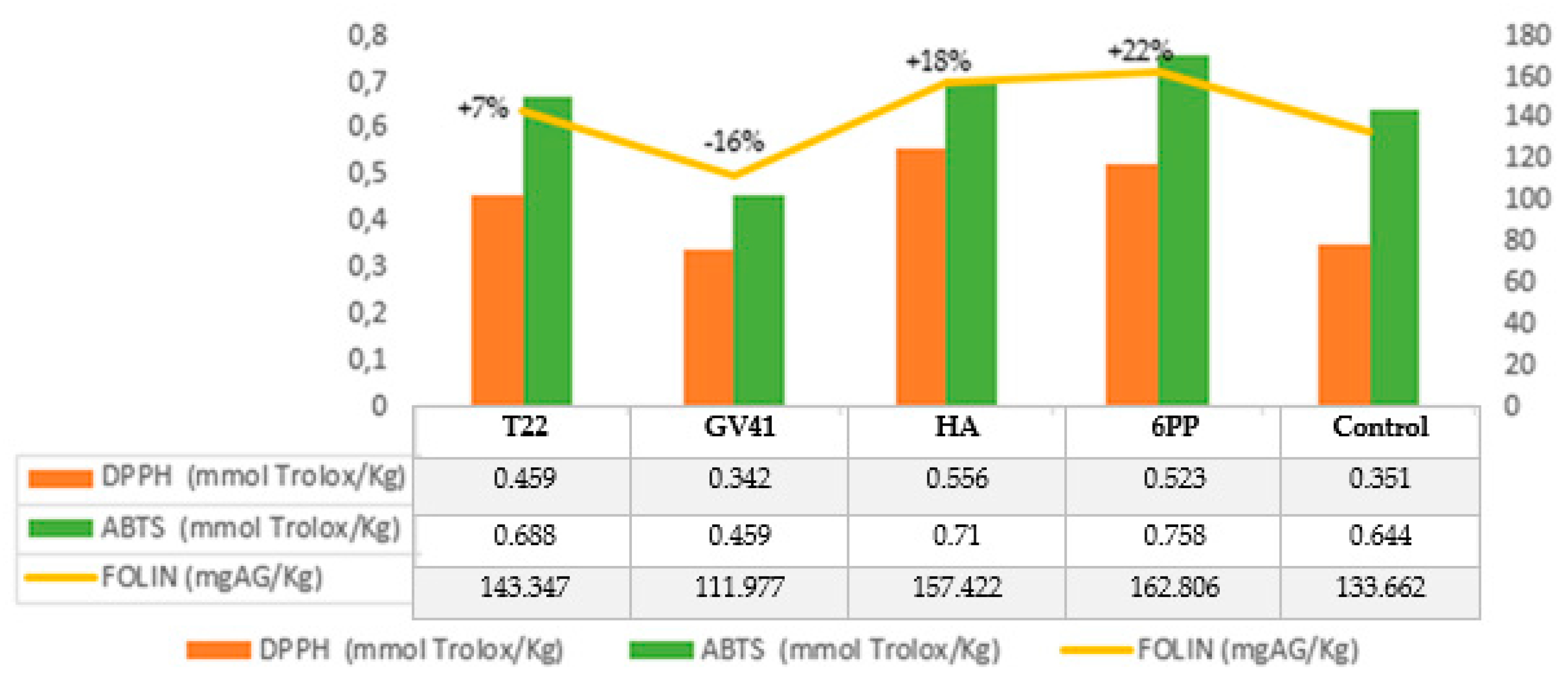
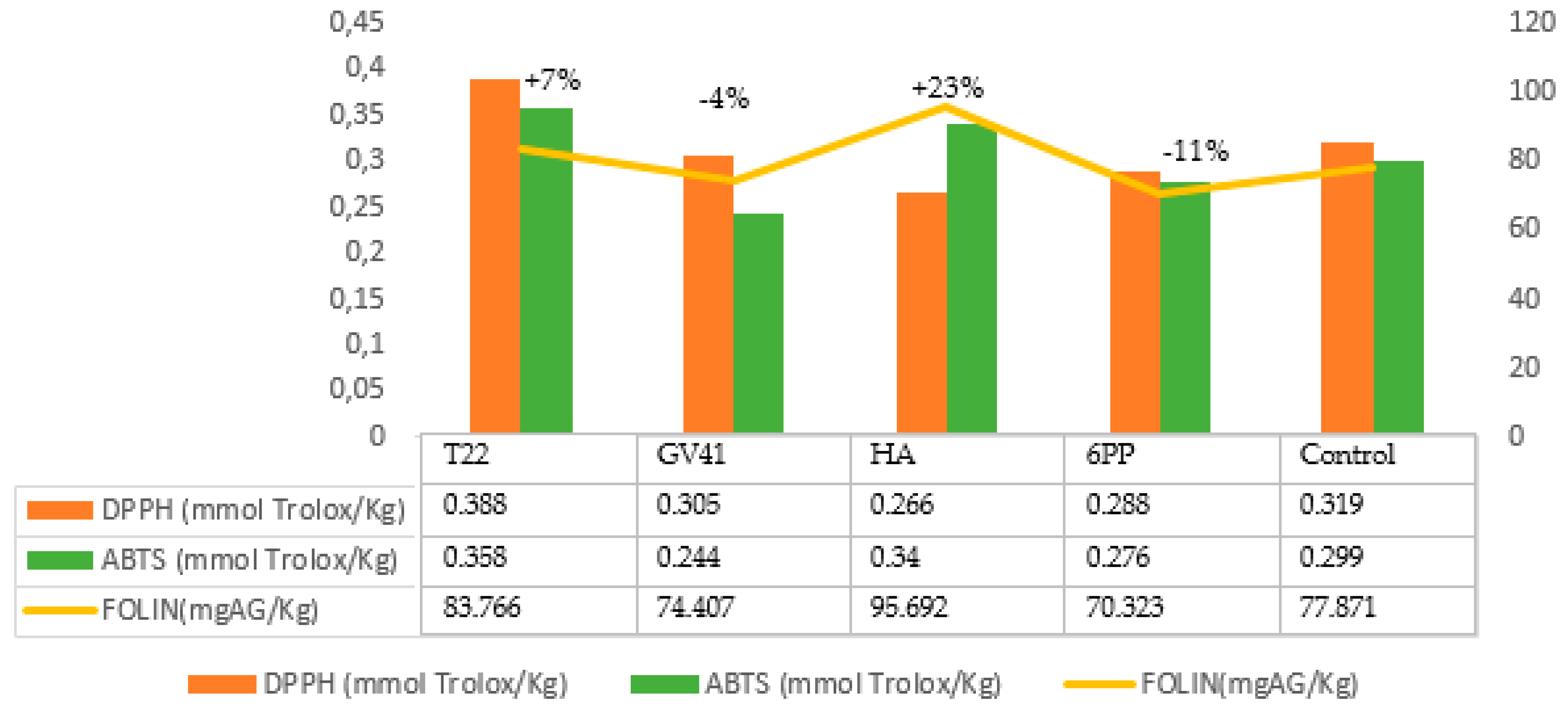
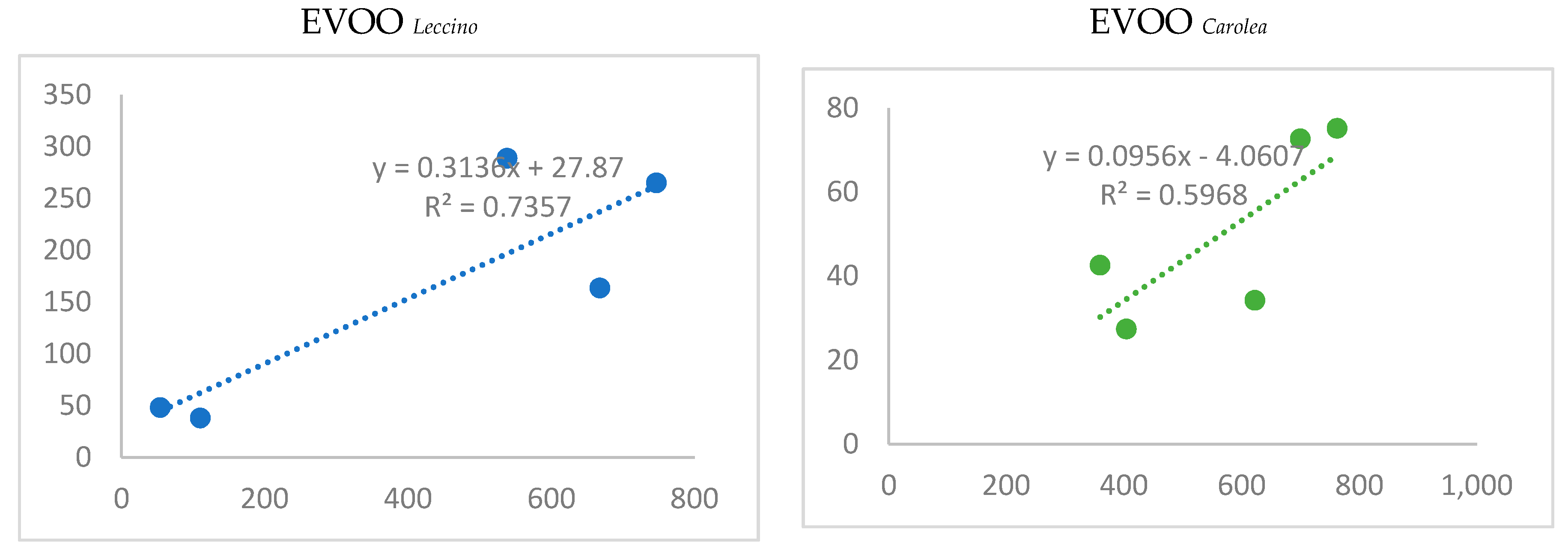

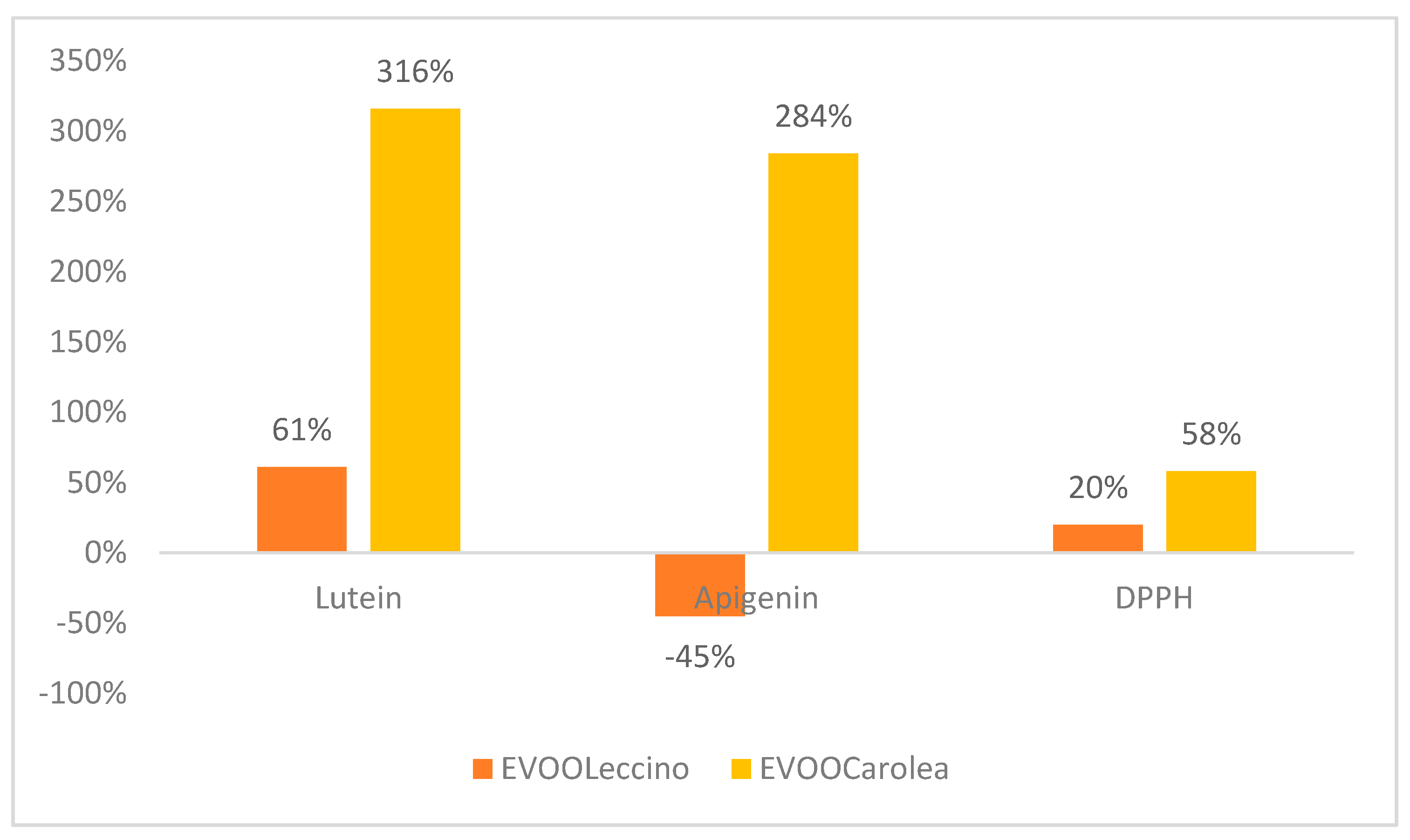
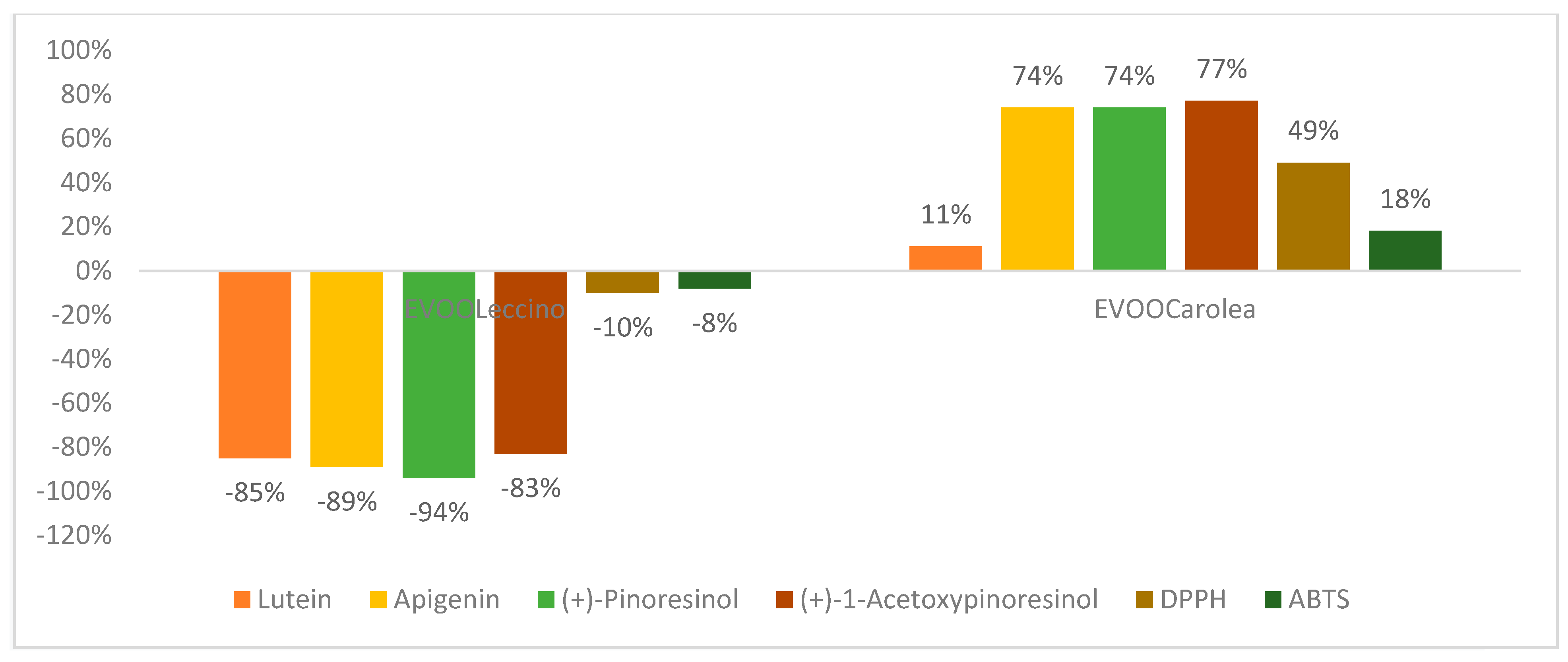
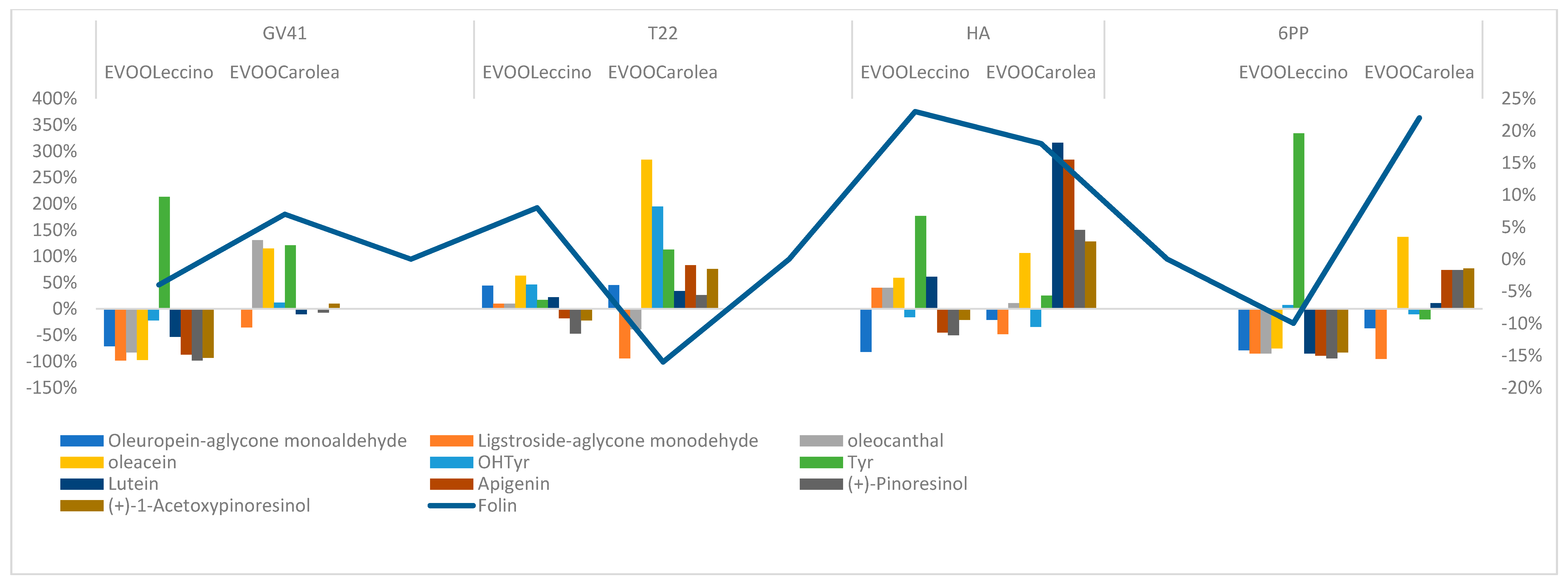
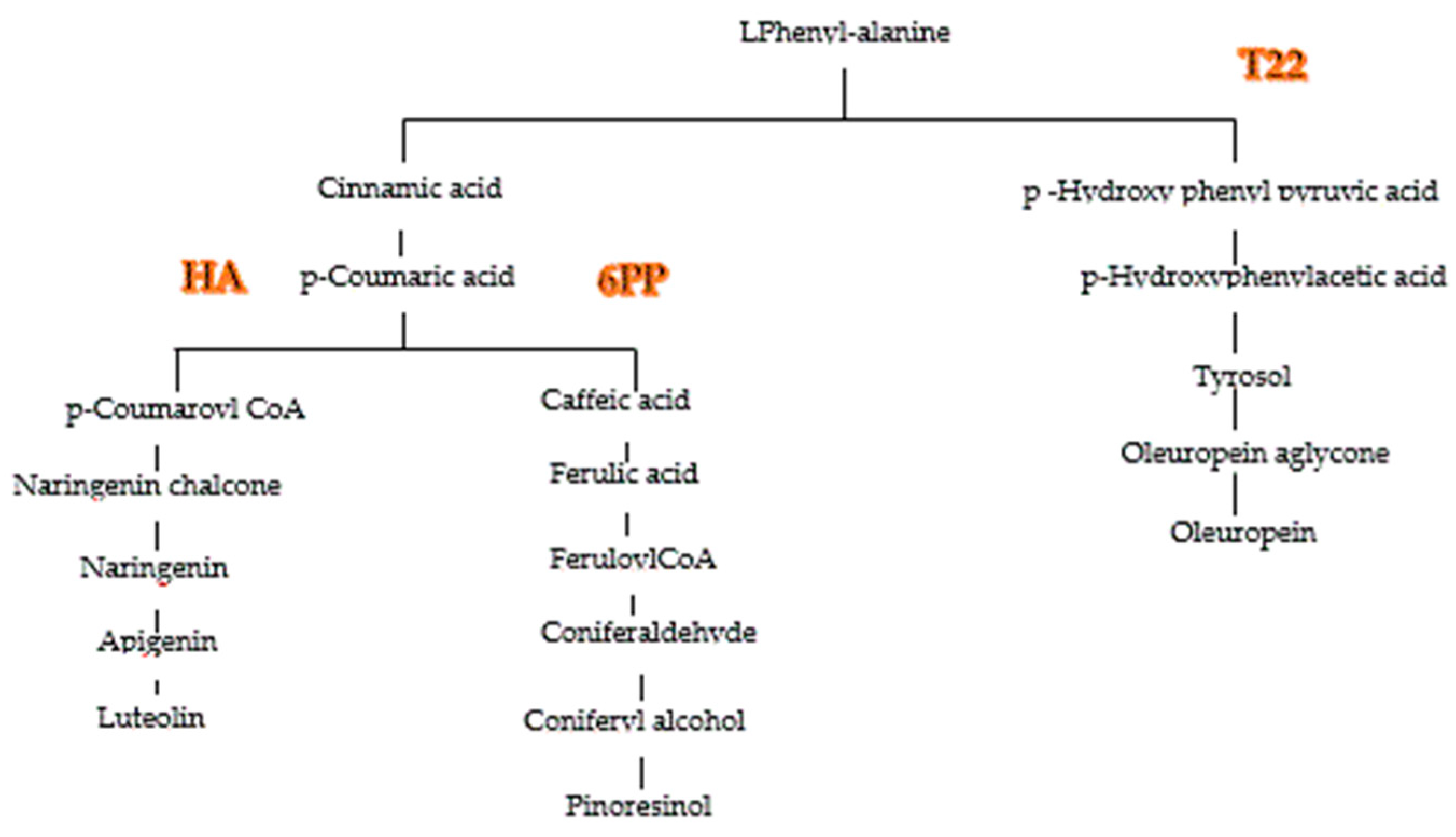
| Phenolic Compounds | RT (min) | Formula | Theoretical m/z of Deprotonated Molecular Ions [M − H]− | Experimental m/z of Deprotonated Molecular ions [M − H]− | Calculated Errors ∆ppm | Fragments | Collision Energy (eV) |
|---|---|---|---|---|---|---|---|
| Phenolic acids | |||||||
| Vanillic acid | 4.30 | C8H8O4 | 167.03498 | 167.03522 | 1.44 | 152.01143 | 20 |
| p-Coumaric acid | 9.71 | C9H10O5 | 163.04007 | 163.04028 | 1.29 | 119.05023 | 20 |
| Cinnamic acid | 11.54 | C9H8O2 | 147.04515 | 147.04536 | 1.43 | 103.04501 | 20 |
| Ferulic acid | 11.81 | C10H10O4 | 193.05063 | 193.05084 | 1.09 | 178.02685 | 20 |
| 4-Hydroxybenzoic acid | 2.57 | C7H6O3 | 137.02442 | 137.02456 | 1.02 | 93.03431 | 12 |
| 3-Hydroxybenzoic acid | 2.88 | C7H6O3 | 137.02442 | 137.02458 | 1.17 | 93.03431 | 12 |
| Flavonoids | |||||||
| Apigenin | 19.12 | C15H10O5 | 269.04555 | 269.04597 | 1.56 | 225.05592 | 35 |
| Luteolin | 19.07 | C15H10O6 | 285.04046 | 285.04106 | 2.10 | 133.02940 | 30 |
| Lignans | |||||||
| (+) Pinoresinol | 17.00 | C20H22O6 | 357.13436 | 357.13487 | 1.43 | 151.03961 | 40 |
| (+) 1-Acetoxypinoresinol | 19.10 | C22H24O8 | 415.13984 | 415.14007 | 0.55 | 415.13821 | 40 |
| Phenolic Alcohols | |||||||
| Hydroxytyrosol (3,4 DHPEA) | 1.60 | C8H10O3 | 153.05572 | 153.05580 | 0.52 | 123.04561 | 12 |
| Tyrosol (p-HPEA) | 2.75 | C8H10O2 | 137.06080 | 137.06096 | 1.17 | 119.05022 | 12 |
| Secoiridoids | |||||||
| Elenolic acid | 13.14 | C11H14O6 | 241.07176 | 241.07212 | 1.49 | 209.04573 | 10 |
| Oleacein (3.4 DHPEA-EDA) | 16.14 | C17H20O6 | 319.11871 | 319.11898 | 0.85 | 301.1082 | 15 |
| Oleuropein | 16.69 | C25H32O13 | 539.17701 | 539.17767 | 1.22 | 377.12393 | 20 |
| Ligstroside | 18.25 | C25H32O12 | 523.18210 | 523.18279 | 1.32 | 361.12914 | 12 |
| Ligstroside-decarboxymethyl aglycone oleocanthal(p-HPEA-EDA) | 18.59 | C17H20O5 | 303.12380 | 303.12441 | 2.01 | 301.1082 | 12 |
| Secologanoside | 19.49 | C16H21O11 | 389.1092 | 389.109258 | 0.59 | 345.1195 | 12 |
| Oleuropein-aglycone mono-aldehyde (3.4 DHPEA-EA) | 21.25 | C19H22O8 | 377.12419 | 377.12442 | 0.61 | 345.09790 | 12 |
| p-HPEA-EA (Ligstroside- aglycone monoaldehyde) | 21.59 | C19H2207 | 361.12145 | 361.12141 | −0.11 | 291.1122 | 21 |
| Phenolic Compounds | Linearity (mg/L) | R2 | LOD (mg/L) | LOQ (mg/L) | Intraday RSD % (n = 3), 50 mg/L |
|---|---|---|---|---|---|
| Phenolic Acids | |||||
| Vanillic acid | 1–50 | 0.887 | 0.200 | 0.600 | 1.1 |
| p-Coumaric acid | 1−50 | 1.000 | 0.100 | 0.300 | 1.8 |
| Cinnamic acid | 1−50 | 0.991 | 0.200 | 0.600 | 0.9 |
| 4-Hydroxybenzoic acid | 1−50 | 0.998 | 0.207 | 0.622 | 0.9 |
| 3-Hydroxybenzoic acid | 1−50 | 0.995 | 0.205 | 0.622 | 1.1 |
| Flavonoids | |||||
| Apigenin | 0.5−50 | 0.899 | 0.066 | 0.200 | 2.1 |
| Luteolin | 0.5−50 | 0.991 | 0.066 | 0.200 | 1.4 |
| Lignans | |||||
| (+) Pinoresinol | 1−50 | 0.999 | 0.02 | 0.060 | 0.5 |
| (+)1-Acetoxypinoresinol | 1−50 | 0.899 | 0.233 | 0.700 | 1.5 |
| Phenolic Alcohols | |||||
| 3.4 DHPEA (Hydroxytyrosol) | 1−50 | 0.992 | 0.666 | 2.000 | 3.0 |
| p-HPEA (Tyrosol) | 1−50 | 0.991 | 0.040 | 0.133 | 1.6 |
| Secoiridoids | |||||
| Elenolic acid | 1−50 | 0.991 | 0.333 | 1.000 | 0.7 |
| Oleuropein | 1−50 | 0.991 | 0.166 | 0.500 | 5.0 |
| Ligstroside | 1−50 | 0.991 | 0.166 | 0.500 | 4.0 |
| Oleocanthal | 1−50 | 0.899 | 0.416 | 1.250 | 3.0 |
| Secologanoside | 1−50 | 0.967 | 0.333 | 1.000 | 2.1 |
| 3.4-DHPEA-EA (Oleuropein-aglycone monoaldehyde) | 1−50 | 0.998 | 1.000 | 3.000 | 2.1 |
| p-HPEA-EA (Ligstroside- aglycone monoaldehyde) | 1−50 | 0.999 | 0.033 | 0.100 | 0.7 |
| 3.4 DHPEA-EDA (Oleacein) | 1−50 | 0.991 | 0.033 | 0.100 | 1.1 |
| Oleuropein | Ligstroside | Secologanoside | Elenolic Acid | p-HPEA-EA | 3.4-DHPEA-EA (Oleuropein-aglycone monoaldehyde) | p- HPEA-EDA (Ligstroside- decarboxymethyl aglycone) | 3.4-DHPEA-EDA (oleacein) | |
|---|---|---|---|---|---|---|---|---|
| Leccino cultivar | ||||||||
| T22 | 0.051 ± 0 | 0.016 ± 0.004 | 0.022 ± 0.003 | 0.782 ± 0.006 | 113.34 ± 0.234 | 151.672 ± 0.018 | 113.34 ± 0.234 | 368.416 ± 5.474 |
| GV41 | 0.062 ± 0.002 | 0.002 ± 0.001 | 0.012 ± 0.001 | 0.176 ± 0.002 | 17.71 ± 0.019 | 30.307 ± 0.503 | 17.71 ± 0.019 | 6.207 ± 0.09 |
| HA | 0.053 ± 0.003 | 0.015 ± 0.002 | 0.083 ± 0.008 | 1.317 ± 0.023 | 144.889 ± 1.349 | 18.578 ± 2.467 | 144.889 ± 1.349 | 359.45 ± 2.078 |
| 6PP | 0.053 ± 0.001 | 0.001 ± 0.001 | 0.004 ± 0.001 | 0.126 ± 0.002 | 15.661 ± 0.343 | 22.335 ± 0.41 | 15.661 ± 0.343 | 56.547±0.319 |
| Control | 0.046 ± 0.003 | 0.007 ± 0.001 | 0.01 ± 0 | 2.704 ± 0.144 | 103.342 ± 0.553 | 105.488 ± 0.506 | 103.342 ± 0.553 | 226.173 ± 0.065 |
| Carolea cultivar | ||||||||
| T22 | 0.056 ± 0.002 | 0.012 ± 0.001 | 0.011 ± 0 | 2.511 ± 0.014 | 139.98 ± 1.635 | 305.157 ± 1.554 | 139.98 ± 1.635 | 114.526 ±0.321 |
| GV41 | 0.064 ± 0.003 | 0.027 ± 0 | 0.118 ± 0.001 | 1.535 ± 0.004 | 249.437 ± 1.244 | 208.585 ± 3.183 | 149.437 ± 1.244 | 55.067 ± 0.1 |
| HA | 0.069 ± 0.001 | 0.023 ± 0.002 | 0.181 ± 0.005 | 5.555 ± 0.071 | 119.875 ± 0.849 | 166.79 ± 0.291 | 119.875 ± 0.849 | 52.865 ± 0.406 |
| 6PP | 0.053 ± 0.001 | 0.001 ± 0.001 | 0.004 ± 0.001 | 2.226 ± 0.01 | 108.81 ± 1.891 | 133.9 ± 1.021 | 108.81 ± 1.891 | 60.665 ± 0.169 |
| Control | 0.377 ± 0.431 | 0.038 ± 0.006 | 0.124 ± 0.009 | 1.28 ± 0.237 | 108.172 ± 15.044 | 210.729 ± 6.933 | 228.172 ± 15.044 | 25.634 ± 6.69 |
| 3.4 DHPEA (Hydroxytyrosol) | p-HPEA (Tyrosol) | |
|---|---|---|
| Leccino cultivar | ||
| T22 | 0.928 ± 0.008 | 155.108 ± 0.731 |
| GV41 | 0.498 ± 0.016 | 164.541 ± 0.932 |
| HA | 0.535 ± 0.01 | 146.029 ± 0.881 |
| 6PP | 0.683 ± 0.005 | 228.288 ± 2.377 |
| Control | 0.636 ± 0.007 | 52.657 ± 0.562 |
| Carolea cultivar | ||
| T22 | 0.308 ± 0.007 | 72.356 ± 0.893 |
| GV41 | 0.294 ± 0.014 | 74.904 ± 3.824 |
| HA | 0.174 ± 0.002 | 42.38 ± 0.75 |
| 6PP | 0.238 ± 0.003 | 27.106 ± 0.901 |
| Control | 0.263 ± 0.009 | 33.916 ± 0.403 |
| (+)-Pinoresinol | (+)-1-Acetoxypinoresinol | |
|---|---|---|
| Leccino cultivar | ||
| T22 | 0.855 ± 0.024 | 38.972 ± 1.817 |
| GV41 | 0.033 ± 0.001 | 3.655 ± 0.108 |
| HA | 0.799 ± 0.007 | 39.227 ± 0.554 |
| 6PP | 0.104 ± 0.003 | 8.715 ± 0.321 |
| Control | 1.608 ± 0.01 | 49.807 ± 0.558 |
| Carolea cultivar | ||
| T22 | 0.376 ± 0.001 | 33.433 ± 0.882 |
| GV41 | 0.276 ± 0.003 | 20.821 ± 0.511 |
| HA | 0.744 ± 0.02 | 43.291 ± 0.269 |
| 6PP | 0.517 ± 0.005 | 33.547 ± 0.516 |
| Control | 0.298 ± 0.063 | 18.967 ± 0.461 |
| Luteolin | Apigenin | |
|---|---|---|
| Leccino cultivar | ||
| T22 | 0.634 ± 0.005 | 0.075 ± 0.001 |
| GV41 | 0.244 ± 0.012 | 0.012 ± 0 |
| HA | 0.835 ± 0.009 | 0.086 ± 0.001 |
| 6PP | 0.08 ± 0.002 | 0.01 ± 0 |
| Control | 0.52 ± 0.015 | 0.091 ± 0 |
| Carolea cultivar | ||
| T22 | 2.749 ± 0.009 | 0.188 ± 0.007 |
| GV41 | 1.841 ± 0.004 | 0.102 ± 0.001 |
| HA | 8.505 ± 0.002 | 0.395 ± 0.005 |
| 6PP | 2.261 ± 0.047 | 0.179 ± 0.003 |
| Control | 2.045 ± 0.346 | 0.103 ± 0.01 |
| 4-Hydroxy Benzoic Acid | 3-Hydroxy Benzoic Acid | Vanillic Acid | p-Coumaric Acid | Cinnamic Acid | Ferulic Acid | |
|---|---|---|---|---|---|---|
| Leccino cultivar | ||||||
| T22 | 0.419 ± 0.013 | 0.031 ± 0.008 | 0.356 ± 0.03 | 0284 ± 0.002 | 0.143 ± 0.002 | 0.144 ± 0.004 |
| GV41 | 0.027 ± 0.002 | 0.02 ± 0.002 | 0.08 ± 0.001 | 0.109 ± 0.005 | 0.023 ± 0.001 | 0.036 ± 0.001 |
| HA | 0.501 ± 0.013 | 0.055 ± 0.01 | 0.599 ± 0.011 | 0.373 ± 0.004 | 0.165 ± 0.003 | 0.179 ± 0.002 |
| 6PP | 0.044 ± 0.001 | 0.007 ± 0 | 0.057 ± 0.001 | 0.036 ± 0.001 | 0.018 ± 0.001 | 0.019 ± 0 |
| Control | 0.56 ± 0.007 | 0.075 ± 0.004 | 1.23 ± 0.066 | 0.381 ± 0.007 | 0.176 ± 0.001 | 0.32 ± 0.005 |
| Carolea cultivar | ||||||
| T22 | 0.166 ± 0.001 | 0.218 ± 0.004 | 1.142 ± 0.006 | 1.23 ± 0.004 | 0.361 ± 0.014 | 0.38 ± 0.003 |
| GV41 | 0.226 ± 0.003 | 0.139 ± 0.005 | 0.698 ± 0.002 | 0.824 ± 0.002 | 0.196 ± 0.001 | 0.294 ± 0.003 |
| HA | 0.345 ± 0.006 | 0.437 ± 0.008 | 2.527 ± 0.032 | 3.805 ± 0.001 | 0.759 ± 0.009 | 0.888 ± 0.011 |
| 6PP | 0.25 ± 0.008 | 0.174 ± 0.002 | 1.013 ± 0.004 | 1.012 ± 0.021 | 0.344 ± 0.005 | 0.313 ± 0.001 |
| Control | 0.308 ± 0.045 | 0.119 ± 0.003 | 0.583 ± 0.108 | 0.915 ± 0.155 | 0.197 ± 0.019 | 0.307 ± 0.007 |
© 2020 by the authors. Licensee MDPI, Basel, Switzerland. This article is an open access article distributed under the terms and conditions of the Creative Commons Attribution (CC BY) license (http://creativecommons.org/licenses/by/4.0/).
Share and Cite
Dini, I.; Graziani, G.; Gaspari, A.; Fedele, F.L.; Sicari, A.; Vinale, F.; Cavallo, P.; Lorito, M.; Ritieni, A. New Strategies in the Cultivation of Olive Trees and Repercussions on the Nutritional Value of the Extra Virgin Olive Oil. Molecules 2020, 25, 2345. https://doi.org/10.3390/molecules25102345
Dini I, Graziani G, Gaspari A, Fedele FL, Sicari A, Vinale F, Cavallo P, Lorito M, Ritieni A. New Strategies in the Cultivation of Olive Trees and Repercussions on the Nutritional Value of the Extra Virgin Olive Oil. Molecules. 2020; 25(10):2345. https://doi.org/10.3390/molecules25102345
Chicago/Turabian StyleDini, Irene, Giulia Graziani, Anna Gaspari, Francesca Luisa Fedele, Andrea Sicari, Francesco Vinale, Pierpaolo Cavallo, Matteo Lorito, and Alberto Ritieni. 2020. "New Strategies in the Cultivation of Olive Trees and Repercussions on the Nutritional Value of the Extra Virgin Olive Oil" Molecules 25, no. 10: 2345. https://doi.org/10.3390/molecules25102345
APA StyleDini, I., Graziani, G., Gaspari, A., Fedele, F. L., Sicari, A., Vinale, F., Cavallo, P., Lorito, M., & Ritieni, A. (2020). New Strategies in the Cultivation of Olive Trees and Repercussions on the Nutritional Value of the Extra Virgin Olive Oil. Molecules, 25(10), 2345. https://doi.org/10.3390/molecules25102345










